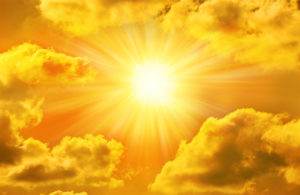Vitamin D has gotten a lot of attention lately, especially when talking about bone health. Can we get enough Vitamin D from the sun and Vitamin D from our food?
But, for the average person, the topic of vitamin D can get confusing. Since anyone can be at risk for having a vitamin D deficiency, I want to make it easier for people to optimize this essential nutrient. Here are some tips for getting your vitamin D level just right.
We first begin by remembering that vitamin D3 is the form we monitor for bone health -- not D2. It's also important to realize there is no one-size-fits-all solution. We all eat different foods, absorb differently, get varying amounts of sun, and have other characteristics affecting vitamin D. That's why we must learn to do this by ourselves.
Optimizing D starts by knowing the existing level, then taking various steps to adjust it. A simple blood test is used to assess the level, one that can be ordered by our doctors. We can also order our own test online (1). Look for a test called "25-D" (or 25, hydroxy-vitamin D) on the page that comes with your lab results. That number represents how much D is already stored in your body, giving you a baseline for what to do next.
Should the results come back low, the goal is to get it up to a healthy level. For the latest recommendations on healthy levels, I turned to a new book called, "Dr. Lani's No-Nonsense Sun Health Guide" [1].
The book recommends a level of 45 ng/ML, or pretty much anywhere in the range of 40-50 ng/ML. The book contains vast amounts of other information about vitamin D, including the other ways it impacts our bodies. But, for Skelly and I, we care mostly about how D takes care of our bones by helping with calcium absorption.
Low Vitamin D
By the way, if having too little D is bad, so is having too much. High vitamin D levels can cause side effects, even toxicity. That's why I encourage everyone to test their level, make any changes, then test it again in two months. It's important to know if what we're doing has made any difference. Life Extensions Lab offers [1] Vitamin D testing is you're unable to get a script from your doctor.
When D is too low, there are several things that can help. One is to eat fortified foods. Another is to see if anything we're doing might be interfering with absorption, like taking certain medications, or not having the right amount of calcium in our bodies.
Vitamin D from food
- Wild caught Salmon contains 988 IU per 3.5 oz (100 grams)
- Fresh Atlantic Herring 216 IU / 3.5 oz (100 grams)
- Canned Sardines 177 IU/ 3.8 oz can (one my favorites)
- Canned Tuna 268 IU / 3.5 oz can (100 grams) watch for methlmercury
- Egg yolk contains 37 IU - pasture raised
- Cheese: Fontina, Muenster, Monterey 30 IU per one cup serving
- Mushrooms have Vitamin D2 - more about mushrooms in my next blog post
Vitamin D from the sun

Another piece of the D puzzle is exposure to the Sun. We know the Sun can help make vitamin D, which is a great thing as long as we're careful not to burn. But, the truth is, most people don't get much from the Sun, if any at all. The biggest reasons including widespread sunscreen use and living above and below certain latitudes on planet Earth where beneficial rays really don't get to us [2] .
Supplementing
Probably the easiest way to raise vitamin D is by taking a supplement. If we start by taking 1,000 IU or 2,000 IU daily for 8 weeks, then re-test, we can see if we're approaching the goal of 45 ng/ML. If not, we can slightly increase the dose for another 8 weeks. For every 1,000 IU of vitamin D3 we take, we can expect to get another 10 point increase.
It's easy math. With a little practice, we can all get this right. I find using a liquid Vitamin D3 makes regulating the dosage easier. Pure Encapsulation makes a liquid Vitamin D3.
Every one of us should be able to optimize our D in only a few months. But, because fluctuations will still happen, it's not a bad idea to retest it once in a while. Testing once during the summer and once during the winter months makes sense to me, but you'll get the hang of things once you get started.
Remember that vitamin D3 is fat soluble, which means it should be taken with a meal containing some fat. Check out these other blogs to find the perfect recipe to compliment your vitamin D supplementation.
- Vitamin D Medicare and Mystery Medical Bill
- Butter is Better - 10 Healthy Reasons Why
- Fishing for Healthy Bones
Coming Soon:
Within the next few weeks I will be releasing my:
Easy Cooking For Bone Health Guide

This 80-page guide was built around questions, you my readers, have submitted when asked "When it comes to feeding your bones, what is your single biggest challenge". I think your bones will love this!
Make sure you're on my email list and you will be notified. Not on my list? Sign up for my 5 Bone-Loving Recipes to the side of this blog post. Then you will be in my email system. You can also share this blog with anyone you know who has bones by using the share links below.
From my bones to yours,
Irma Jennings, Holistic Bone Coach
References:
Want more support? Join my Osteoporosis and Food Facebook Page. That's where I post weekly on Food for Healthy Bones.
Let Me Support Your Bones
Get Customized In-Depth Private Session
Book a Private Coaching with Irma Now
Join Our Amazing Bone Tribe Community
Get the support & information you need to live fearlessly with your bones diagnosis
From my bones to yours,
Irma Jennings, INHC
Your Holistic Bone Coach
[email protected]

